www.wimb.net - Stepper Motor Information

Stepper Motor Connections
Stepper motors are available in many different models. One of the main differences is the number of connections. That can vary from 4 to 8 wires or terminals.
The oldest models, for the unipolar drives have 5 or 6 leads. The newest ones for the bipolar drives and do have only 4 leads.
Motor connections
Below is an overview of all possible stepper motor connections. If you find a motor with a number of wires not mentioned below then there is something wrong. If, for example a motor has 7 wires then there are two possibilities:
- It is a six lead motor and the "seventh" wire is the ground connection
- It was an eight lead motor and the "eight" wire is broken or removed
| Motor Leads |
Unipolar Drive |
Bipolar Drive |
|---|---|---|
| 8 | As 6 or 5 lead motor | Serial or parallel connection |
| 6 | As 6 or 5 lead motor | Serial or One Winding |
| 5 | As 5 lead motor | Not possible |
| 4 | Not possible | Standard Connection |
Unipolar Drive - 5, 6 and 8 leads
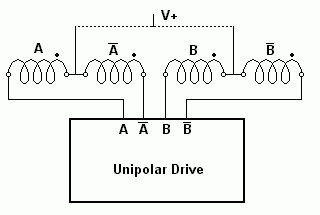
- 5 Leads
- This one has a common connection between all windings. Therefore it can be driven only by a unipolar drive. A bipolar drive cannot be used.
- 6 Leads
- Each winding has a separate middle connection point. This point goes to a power supply voltage, direct, or via a resistor.
- 8 Leads
- For use on an unipolar drive, an 8 lead motor can be connected as a 5 or 6 lead motor.
The 5 and 6 leads motors are the oldest models. Their construction comes straight from the synchronous motor with two windings. The windings are split in the middle and connected to a powersupply. In most cases there was a current limeting resistor between the windings and the power supply. An example value is 4.5 Ohm for a 4 amp motor. These resistors were generating a lot of heat and they keep also the efficiency very low.
Bipolar Drive - 6 and 8 leads - Serial Connection
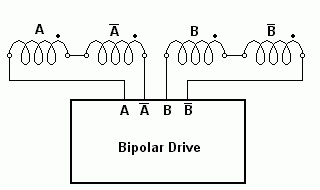
- 6 Leads
- The windings are connected in serial. Since most 6 lead motors are wound bifilar - link -, so the inductance will be quadruple of the single winding value.
- 8 Leads
- The windings are connected in serial. Since most 8 lead motors are wound monofilar - link -, then the inductance will be double. If the motor was wound bifilar - link -,the inductance will be quadruple of the single winding value.
Almost all 6 leads motors can be connected to a bipolar drive, but the performance will be not at the maximum. However, when an old unipolar drive is replaced by a new bipolar one in general the performance will be better. Serial connection of the windings is basicly for high torque and low speed applications.
Bipolar Drive - 6 and 8 leads - Single Winding
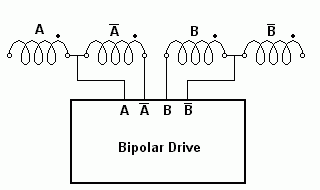
- 6 Leads
- Due to the much lower inductance then with two windings in serial, the motor may run a lot faster. This can be a good solution when an old unipolar drive has to be replaced by a bipolar one.
- 8 Leads
- This is a unusual connection. In most cases it is better to connect the windings in serial or parallel.
This special connection can be used when a 6 lead motor, with serial windings has a too high inductance. For an eight lead motor this is not a very common connection.
Bipolar Drive- 8 leads - Windings Parallel
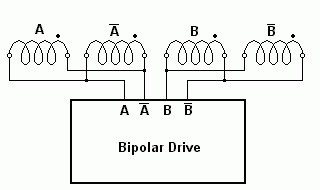
- 8 Leads
- This is the standard high speed connection for an eight lead motor.
With the windings in parallel, the motor current can be higher whilt the inductance is lower. This is a typical connection for a motor that need to run at a high speed..
4 leads - Bipolar Drive
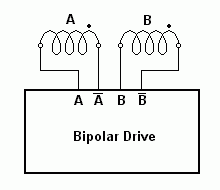
- 4 Leads
- The standard connection for a four lead motor.
This is the standard connection for a bipolar drive. Please note that the motor seems to have only two windings, but this is not true. There are still four windings and, depending on motor type, they are in series or parallel. Most manufacturers makes two models with the same winding, but one time connected is series and one time in parallel.
Updated 2007 Oct. 09


